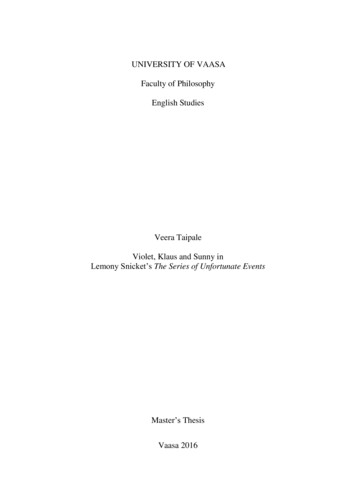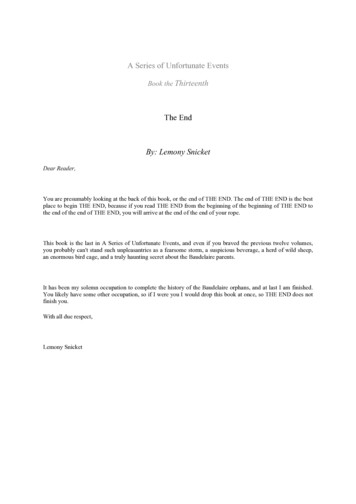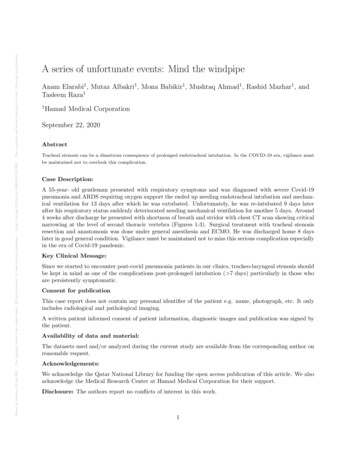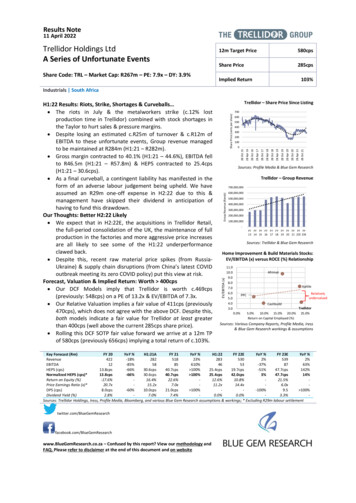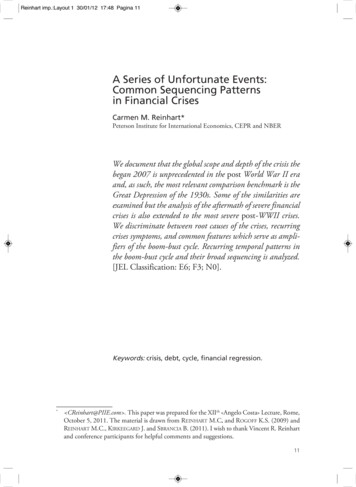
Transcription
Reinhart imp.:Layout 1 30/01/12 17:48 Pagina 11A Series of Unfortunate Events:Common Sequencing Patternsin Financial CrisesCarmen M. Reinhart*Peterson Institute for International Economics, CEPR and NBERWe document that the global scope and depth of the crisis thebegan 2007 is unprecedented in the post World War II eraand, as such, the most relevant comparison benchmark is theGreat Depression of the 1930s. Some of the similarities areexamined but the analysis of the aftermath of severe financialcrises is also extended to the most severe post-WWII crises.We discriminate between root causes of the crises, recurringcrises symptoms, and common features which serve as amplifiers of the boom-bust cycle. Recurring temporal patterns inthe boom-bust cycle and their broad sequencing is analyzed.[JEL Classification: E6; F3; N0].Keywords: crisis, debt, cycle, financial regression.* CReinhart@PIIE.com . This paper was prepared for the XIIth «Angelo Costa» Lecture, Rome,October 5, 2011. The material is drawn from REINHART M.C. and ROGOFF K.S. (2009) andREINHART M.C., KIRKEEGARD J. and SBRANCIA B. (2011). I wish to thank Vincent R. Reinhartand conference participants for helpful comments and suggestions.11
Reinhart imp.:Layout 1 30/01/12 17:48 Pagina 12Rivista di Politica EconomicaOctober/December 2010-20111. - Introduction«Over indebtedness simply means that debts are out-of-line, are too big relative to other economic factors. It may be started by many causes, of whichthe most common appears to be new opportunities to invest at a big prospective profit such as through new industries Easy money is the great causeof over-borrowing».IRVING FISHER (1933)The issues I address fall into three broad areas or sections. The next sectiontakes stock of the collateral damage, in terms of the incidence of banking crisesand currency and crashes around the world, which followed the financial turmoilthat began as the subprime crisis in the United States in the summer of 2007.Following a common pattern in history, the financial crash has more recentlymorphed into full-fledged sovereign crises engulfing (to date), in varying degrees,Greece, Portugal, Ireland, Italy and Spain.1 Apart from its impact on domesticand international financial flows, not to mention the changes in the landscape ofthe financial industry, that this crisis has produced, the toll on the real economyhas been great. The evolution of world trade helps to illustrate the breadth anddepth of the economic downturn. Global equity prices have also followed a rollercoaster pattern since the onset of crisis about four years ago. The evidence presented here places these developments in a broader historical and internationalperspective that allows us to gauge the unusual severity of the unfolding globalcrisis. Section III dwells on the aftermath of severe financial crises, and speculateswhere we might be in the post-crisis cycle. The comparisons focus primarily onthe housing and labor markets, where the aftereffects of the crises have tended tolinger the longest. The fiscal implications and consequences of severe crises arediscussed. Section IV poses the question of what causes these great crises andwhat factors make them more severe. The focus of this discussion is on causalfactors that are common to severe financial crises across countries and across timerather than those that are idiosyncratic to the political and economic circumstances of the latest episode. The last section discusses on the high (and rapidlyrising) levels of public sector indebtedness in nearly all the advanced economiesand its implication for the “international financial architecture” in the form offinancial repression in years to come.112REINHART M.C. and ROGOFF K.S. (2011b).
Reinhart imp.:Layout 1 30/01/12 17:48 Pagina 13C. M. REINHARTA Series of Unfortunate Events: Common Sequencing Patterns .2. - Taking Stock: The Global Dimensions of the Crisis2.1 A Global Crisis IndexSo, where are we in a historical global context? We present an index whichproxies of world economic turbulence. These aggregate crisis indices are the timeseries shown for 1900-2010 in Graph 1 for the “World”. The indices shown areweighted by a country’s share in world GDP, as we have done for debt and banking crises. The 66-country sample accounts for about 90 percent of world GDP.The country indices (without stock market crashes) are compiled from the timeof independence (if after 1800) onward; the index that includes the equity marketcrashes is calculated based on data availability. While inflation and banking crisespredate independence in many cases, a sovereign debt crisis (external or internal)is by definition not possible for a colony. In addition, numerous colonies did notalways have their own currencies. The BCDI index stands for banking (systemicepisodes only), currency, debt (domestic and external), and inflation crisis index.When stock market crashes are added (shown separately) to the BCDI composite,we refer to it as the BCDI .Graph 1 chronicles and summarizes the incidence, and to some degree theseverity of varied crisis experience. A cursory inspection of the Graph reveals a verydifferent pattern for the pre- and post-WWII experience. The pre-war experienceis characterized by frequent and severe crises episodes ranging from the bankingcrisis driven “global” panic of 1907 to the debt and inflation crises associated withWorld War II and its aftermath. The only period during the post war that we seeas high an incidence of crises is the fifties where, during World War II big countries – Germany, Austria, Japan, Italy – were in a state of default and remained sothrough the early fifties. Plus, of course, there were a lot of countries that had goneinto default in the thirties that were still in default. But since the immediate aftermath of World War II, we had not seen a crisis this global in scope.The sharp rise in the heavy line (BCDI index) that we see in 2007 and moreso in 2008 is mostly dominated by banking crises and also currency crashes. Indeed, a large share of countries in the fall of 2008 had sufficiently large depreciations to classify as a currency crash (i.e., exchange rate depreciations exceeding15 percent). The thin line adds stock market crashes – which were ubiquitous in2008-2009. No doubt, when the index is updated to reflect year-end 2011 pricelevels, it will reveal yet another wave of stock market crashes.13
Reinhart imp.:Layout 1 30/01/12 17:48 Pagina 14Rivista di Politica EconomicaOctober/December 2010-2011GRAPH 1VARIETIES OF CRISES: WORLD AGGREGATE, 1900-2010 A COMPOSITE INDEXOF BANKING, CURRENCY, SOVEREIGN DEFAULT, INFLATION CRISES,AND STOCK MARKET CRASHES(Weighted by their share of world income)Notes: The banking, currency, default (domestic and external) and inflation composite (BCDI index) can take avalue between 0 and 5 (for any country in any given year) depending on the varieties of crises taking place on aparticular year. For instance, in 1998 the index took on a value of 5 for Russia, as there was a currency crash, abanking and inflation crisis, and a sovereign default on both domestic and foreign debt obligations. This index isthen weighted by the country’s share in world income. This index is calculated annually for the 66 countries inthe sample for 1800-2010:6 (shown above for 1900-onwards). We have added, for the borderline banking casesidentified LAEVEN L. and VALENCIA F. (2010) for the period 2007-2010. In addition, we use the BARRO R.J. andURSÚA J. (2008) definition of a stock market crash for the 25 countries in their sample (a subset of the 66-countrysample-except for Switzerland) for the period 1864-2006; we update their crash definition through June 2010, tocompile our BCDI index. For the United States, for example, the index posts a reading of 2 (banking crisis andstock market crash) in 2008; for Australia and Mexico it also posts a reading of 2 (currency and stock marketcrash).14
Reinhart imp.:Layout 1 30/01/12 17:48 Pagina 15C. M. REINHARTA Series of Unfortunate Events: Common Sequencing Patterns .2.2 World TradeAs to trade, we offer we offer an illustration of the evolution of trade duringtwo global crises. Graph 2 plots the value of World merchandise exports for 19282010. The estimate for 2009 uses the actual year-end level for 2008 as the averagefor 2009; this yields a 9 percent year-over-year decline in 2009, the largest oneyear drop since 1938.2 Other large post-WWII declines are in 1952, during theKorean War and in 1982-1983, when recession hit the United States and a 1930sscale debt crisis swept through the emerging world. Smaller declines occurred in1958, the bottom of a recession in the United States, 1998 during the Asian financial crisis and in 2001, after September 11.GRAPH 2WORLD EXPORT GROWTH, 1928-2010(annual percent change)Sources: GLOBAL FINANCIAL DATA (GFD), League of Nations, World Economic Survey (various issues), INTERNATIONAL MONETARY FUND, World Economic Outlook, and the authors (see notes).Notes: The estimate for 2010 is from the World Economic Outlook. The 20.4 percent year-over-year decline in2010, is the largest post-war drop.2While we have reliable trade data for most countries during World War II, there are sufficientmissing entries so as to make the calculation of the world aggregate not comparable to otheryears during 1940-1947.15
Reinhart imp.:Layout 1 30/01/12 17:48 Pagina 16Rivista di Politica EconomicaOctober/December 2010-20112.3 The “Big Picture”In sum, Graphs 1-2 highlight the breadth, depth, and internationally synchronous nature of the post-2007 financial crisis, especially in relation to the mildermore scattered crises episodes of the post war landscape. Even “significant global”events, such as the break-down of the Bretton Woods system of fixed exchangerates, the oil shocks of the mid-1970s and the emerging market debt crisis of theearly 1980s, pale in comparison in terms of the incidence of crises and impactson the real economy. Indeed, the output declines registered in many advancedand emerging market economies in 2009 rank among the largest declines in thehistory of the national income accounts. In several countries, the declines in realGDP during the second great contraction (2008-2009) matched and even exceeded those recorded during severe “home grown” financial crises. This list includes such diverse countries (crisis year in parentheses) as Finland (1991);Mexico (1995); Singapore (1982); Spain (1977); Sweden (1991); Turkey (2001),among others.Having suggested that the severity of this crisis is on a different scale from thepost-war norm, it is logical sequel to expect that the aftermath of the crisis will,in all likelihood, also depart from the “standard” post-war recession-recovery pattern. To this end, the next section summarizes selected empirical findings of theReinhart and Rogoff (2011a) study on the aftermath of severe financial crises.3. - The Aftermath of Financial CrisesLet me begin by observing that, as to the present conjuncture in the UnitedStates, the post-war recession experience should not be seen as an instructivebenchmark for where we are at present or what we should expect. The averageNBER post-war recession lasts less than a year. The worst one lasted 16 months.We passed those milestones.Broadly speaking, financial crises are protracted affairs. More often than not,the aftermath of severe financial crises share three characteristics. First, asset market collapses are deep and prolonged. Real housing price declines average 35 percent stretched out over six years. Second, the aftermath of banking crises isassociated with profound declines in output and employment. The unemployment rate rises an average of 7 percentage points over the down phase of the cycle,which lasts on average over four years. Third, the real value of government debttends to explode, rising an average of 86 percent in the major post-World War II16
Reinhart imp.:Layout 1 30/01/12 17:48 Pagina 17C. M. REINHARTA Series of Unfortunate Events: Common Sequencing Patterns .episodes. Interestingly, the main cause of debt explosions is not the widely citedcosts of bailing out and recapitalizing the banking system. In fact, the biggestdriver of debt increases is the inevitable collapse in tax revenues that governmentssuffer in the wake of deep and prolonged output contractions.3.1 UnemploymentTo illustrate, Graph 3 examines unemployment rates in the wake of the14 worst financial crises in the post war. And what the left panel shows is the increase in the unemployment rate from the low point to the high point. So, it’sthe cumulative increase in unemployment for that particular crisis. What theright panel shows is the duration in years of the time it takes to go from the lowestunemployment level to the highest. On average from bottom to peak, unemployment increases by about 7 percentage points during the worst financial crises. Inthe US context, low point in unemployment in 2006 was around 4 percent - a 7percentage point increase would take it to 11 percent. The average duration (bottom to peak) is 4.8 years.These indices are the official unemployment rates; we are now all aware ofmore encompassing measures, such as U6 that are much higher than this whenyou take into account underemployment and so on. That’s not reflected in thesenumbers.To reiterate, recovery in the aftermath of severe financial crises are protractedaffairs, in general.17
Reinhart imp.:Layout 1 30/01/12 17:48 Pagina 18Rivista di Politica EconomicaOctober/December 2010-2011GRAPH 3PAST UNEMPLOYMENT CYCLES AND BANKING CRISES: TROUGH-TO-PEAKPERCENT INCREASE IN THE UNEMPLOYMENT RATE (LEFT PANEL)AND YEARS DURATION OF DOWNTURN (RIGHT PANEL)Sources: OECD, IMF, Historical Statistics of the United States (HSOUS), various country sources, and authors’ calculations.Notes: Each banking crisis episode is identified by country and the beginning year of the crisis. Only major (systemic) banking crises episodes are included, subject to data limitations. The historical average reported does notinclude ongoing crises episodes.3.2 Public DebtWhere there is a substantial economic downturn, high and rising unemployment, and imploding real estate prices – major fiscal consequences should be expected. Not surprisingly, the true legacy of a major financial crisis is moregovernment debt. Graph 4 shows the rise in real government debt in the threeyears following a banking crisis. The deterioration in government finances is striking, with an average debt rise of over 86 percent. We look at percentage increasein debt, rather than debt-to-GDP, because sometimes steep output drops wouldcomplicate interpretation of debt-GDP ratios. As Reinhart and Reinhart (2009)note, the characteristic huge buildups in government debt are driven mainly bysharp falloffs in tax revenue.18
Reinhart imp.:Layout 1 30/01/12 17:48 Pagina 19C. M. REINHARTA Series of Unfortunate Events: Common Sequencing Patterns .Importantly, however, another major contributor to the public debt buildupin past crises as well as the current one is the fact that private debts before a crisisbecome public debts afterwards. Nowhere is this pattern more evident in recenthistory that in Ireland, where the debt/GDP of general government stood ataround 25 percent in 2007 and has since more than quadrupled.3 In the UnitedStates, in early 2010 the transfer of the two mortgage giants, Fannie and Freddie,added 25 percent to the general government’s debt-to-GDP ratio.GRAPH 4CUMULATIVE INCREASE IN REAL PUBLIC DEBT IN THE THREE YEARSFOLLOWING THE BANKING CRISISSources: REINHART M.C. and ROGOFF K.S. (2009) and sources cited therein.Notes: Each banking crisis episode is identified by country and the beginning year of the crisis. Only major (systemic) banking crises episodes are included, subject to data limitations. The historical average reported does notinclude ongoing crises episodes, which are omitted altogether, as these crises begin in 2007 or later, and debt stockcomparison here is with three years after the beginning of the banking crisis.3REINHART M.C. (2010) documents numerous episodes where private debts ended up in thepublic sector balance sheet.19
Reinhart imp.:Layout 1 30/01/12 17:48 Pagina 20Rivista di Politica EconomicaOctober/December 2010-20114. - Causes, Symptoms, and Amplifiers of Financial CrisesAs to the causes of these great crises, we next focus on those factors that arecommon across time and geography; we discriminate between root causes of thecrisis, its symptoms, and features such as financial regulation which serve as amplifiers of the boom-bust cycle. Pertinent to the globalization theme of this conference, the discussion begins with the link between financial liberalization(internal and external), the financial innovation and credit booms these spawnand banking crises.4.1 The RootsThere is a striking correlation between freer capital mobility and the incidenceof banking crises, as shown in Graph 5. Periods of high international capital mobility have repeatedly produced international banking crises, not only famously as theydid in the 1990s, but historically. The Graph plots a three-year moving average ofthe share of all countries experiencing banking crises on the right scale. On theleft scale, we graph the index of capital mobility, due to Obstfeld and Taylor(2004), updated and back cast using their same design principle, to cover our fullsample period. While the Obstfeld-Taylor index may have its limitations, we feelit nevertheless provides a concise summary of complicated forces by emphasizingde facto capital mobility based on actual flows.For the post-1970 period, Kaminsky and Reinhart (1999) present formal evidence on the links of crises with financial liberalization. In 18 of the 26 bankingcrises they study, the financial sector had been liberalized within the precedingfive years, usually less. In the 1980s and 1990s most liberalization episodes wereassociated with financial crises of varying severity. Only in a handful of countries(for instance, Canada) did financial sector liberalization proceed smoothly. Specifically, the paper presents evidence that the probability of a banking crisis conditional on financial liberalization having taken place is higher than theunconditional probability of a banking crisis.20
Reinhart imp.:Layout 1 30/01/12 17:48 Pagina 21C. M. REINHARTA Series of Unfortunate Events: Common Sequencing Patterns .GRAPH 5CAPITAL MOBILITY AND THE INCIDENCE OF BANKING CRISES:ALL COUNTRIES, 1800-2010Sources: BORDO M. et AL. (2001); CAPRIO G. JR. and KLINGEBIEL D. (2003); CAPRIO G. et AL. (2005); KAMINSKYG. and REINHART C.M. (1999); LAEVEN L. and VALENCIA F. (2010); OBSTFELD M. and TAYLOR A.M. (2004)and these authors.Notes: This sample includes all countries (even those not in our core sample of 66). The full listing of bankingcrises dates are shown in APPENDIX II. On the left scale, we updated our favorite index of capital mobility, admittedly arbitrary, but a concise summary of complicated forces. The smooth thin line shows the judgmentalindex of the extent of capital mobility given by OBSTFELD M. and TAYLOR A.M. (2004), back cast from 1800 to1859 using their same design principle.4.2 The SettingAcross countries and over the centuries, economic crises of all type follow asimilar pattern. An innovation emerges. Sometimes it is a new tool of science ofindustry, such as the diving bell, steam engine, or the radio. Sometime it is a toolof financial engineering, such as the joint-stock company, junk bonds, or collateralized debt obligations. These usually accompany or are a direct result of financialliberalization, as described above. Investors may be wary at first, but then they seethat extraordinary returns appear available on these new instruments and they rushin. Financial intermediaries – banks and investment companies – stretch their balance sheets so as not to be left out. The upward surge in asset prices continues,and that generation of financial market participants concludes that rules have beenrewritten: risk has been tamed, and leverage is always rewarded. All too often, pol21
Reinhart imp.:Layout 1 30/01/12 17:48 Pagina 22Rivista di Politica EconomicaOctober/December 2010-2011icy makers assert that the asset-price boom is a vote of confidence on their regime –that “this time is different”. Only seldom, to my knowledge, do they protest thatperhaps the world has not changed and that the old rules of valuation still apply.Marichal (1989), Winkler (1933) and Wynne (1951) all relate variants of thisstory in the chronicles of the crisis of the 19th and early 20th century.But the old rules do apply. The asset price rise peters out, sometimes from exhaustion on its own or sometimes because of a real shock to the economy. Thisexposes the weaknesses of the balance sheets of those who justified high leverageby the expectation of outsized capital gains. Many financial firms admit losses,and some ultimately fail. All those financial firms hunker down, constrictingcredit availability in an effort to slim their balance sheets. With wealth lower andcredit harder to get, economic activity typically contracts. Only after the lossesare flushed out of the financial system and often with the encouragement of lagging monetary and fiscal ease does the economy recover.4.3 The SymptomsThe recurring historical pattern described above is associated with some welldefined symptoms. I will focus here on a few of the symptoms or quantitativeparallels (those listed in Table 1) that have been present during the current crisisin several countries and that we have seen systematically in numerous earlier crisesin advanced and emerging market economies alike.4 Specifically, large capital inflows, sharp housing and equity price run-ups lead the “leading indicator” group.So have been surges in private domestic and external debts. These symptoms arequantifiable, unlike the more nebulous amplifiers that are discussed in the remainder of this section.TABLE 1QUANTITATIVE ANTECEDENTS OF FINANCIAL CRISES:THE “LEAD” OF THE LEADING INDICATORSLarge capital inflowsSharp run-ups in equity pricesSharp run-ups in housing pricesInverted V-shaped growth trajectoryMarked rise in indebtedness422These and other economic and financial indicators are analyzed in detail in KAMINSKY G. andREINHART C.M. (1999).
Reinhart imp.:Layout 1 30/01/12 17:48 Pagina 23C. M. REINHARTA Series of Unfortunate Events: Common Sequencing Patterns .If we were to quantify periods of capital flow bonanzas – periods where capitalinflows are unusually large – who comes up on the radar screen prior to the 20072009 crisis? As Reinhart and Reinhart (2009) document, in addition to the USand the UK, the other names that are listed there – Spain, Italy, Iceland, Ireland –are all countries that have had a period where the large capital inflows endedbadly. Capital inflows facilitate domestic lending, fuel asset prices, and in mostinstances increase the indebtedness of the private sector, the public sector (if thegovernment behaves procyclically), or both.TABLE 2CAPITAL INFLOWS TYPICALLY SURGE AHEAD OF FINANCIAL CRISISCountries with recent notable capital inflows200620072008Bulgaria Iceland Italy Jamaica Latvia New Zealand Pakistan Romania Slovenia South Africa Spain Turkey United Kingdom United States Source: REINHART C.M. and REINHART V.R. (2009).Notes: For the full list of recent bonanza episodes see the paper.There is a sense that the US housing price bubble during 2000-2006 (primarily)is both unique and unprecedented. The magnitude of the bubble is certainly unprecedented to the United States – at least during the past century for which wehave comparable data. However, in a broader global context, the sub-prime bubble is neither unique to the US nor it magnitudes out of line with other real estatebubbles that have also ended equally lamentably in financial crises.23
Reinhart imp.:Layout 1 30/01/12 17:48 Pagina 24Rivista di Politica EconomicaOctober/December 2010-2011Graph 6 compares the run-up in housing prices. Period T represents the yearof the onset of the financial crisis. By that convention, period T-4 is four yearsprior to the crisis, and the graph in each case continues to T 3, except of coursein the case of the US 2007 crisis, which remains in the hands of the fates.5 Thechart confirms the case study literature, showing the significant run-up in housingprices prior to a financial crisis. Notably, the run-up in housing prices in theUnited States exceeds that of the “Big Five” crises (Spain, 1977, Norway, 1987,Finland, 1991, Sweden 1991, and Japan 1992).The boom in real housing prices (or real estate, and other asset prices, morebroadly) is fueled by ample domestic credit availability, large capital inflows, andthe easy liquidity environment that, and that this facilitates the boom. Couplingthe ample liquidity environment with the presumption that this time is differentand that the old rules of valuation do not apply, then you have the makings orthe ingredients for a crisis.As to growth (inverted V-shaped pattern) – growth does very well ahead of thecrisis when credit is ample and wealth effects are positive (as asset prices climb)and falls subsequently. For further evidence the reader is referred to Reinhart andRogoff (2011b).I cannot stress enough the importance of the last entry in Table 1, a markedrise in indebtedness. Rising indebtedness can be domestic, external or both. In canbe private, public or both. Any combination of these forms of rising indebtednesshas been a hallmark of the pre-crisis period as far back as our data can take us.Perhaps Iceland illustrates this point in its most extreme form, as external debtsrise from about 90 percent of GDP in 2000 to well over 900 percent of GDP in2009. It is worth noting that stating that there are capital inflows is usually a different way of observing that a country is borrowing from the rest of the world.524For the United States, house prices are measured by the Case-Shiller index, described and provided in SHILLER R. (2005).
Reinhart imp.:Layout 1 30/01/12 17:48 Pagina 25C. M. REINHARTA Series of Unfortunate Events: Common Sequencing Patterns .GRAPH 6PERCENT CHANGE IN REAL HOUSING PRICES (2002-2006)AND BANKING CRISISDark shading crisis; pale shading (grey)no recent crisis indicates financial crisisbeginning 2007-2008.Source: REINHART M.C. and ROGOFF K.S. (2009).4.4 The “Amplifiers”The list (shown on Table 3) of what I have dubbed the “usual suspects” (whichranges from pro-cyclical macroeconomic policies to overvalued currencies and myopic rating agencies) despite its breadth is not meant to be exhaustive. It is a listthat has withstood the test of time, as several of these amplifiers come up on a re25
Reinhart imp.:Layout 1 30/01/12 17:48 Pagina 26Rivista di Politica EconomicaOctober/December 2010-2011curring and it is those are not unique to the United States subprime crisis. Countless case studies of banking crises, across countries and time (see references in Reinhart and Rogoff, 2011b) list these factors on a recurring basis-often blamed asunderlying causes of the crises. However, it is my view that these factors exacerbateboth the boom and bust phases of the crisis cycle. For example, the stylized evidence presented in Caprio and Klingebiel (1996) suggests that inadequate regulation and lack of supervision at the time of the liberalization may play a key role inexplaining why deregulation and banking crises are so closely entwined. But it isdifficult to explain a cycle with a constant. Supervision may have always been lacking and the regulations ill defined. But such deficiencies may have limited consequences when credit conditions are tight (or in the case of emerging markets whenaccess to international capital markets is not possible). If, on the other hand, financial liberalization (domestic and external) create lending possibilities that didnot exist before, then inadequate supervision can make a bad lending scenarioworse. Outright fraud, (often through connected lending) which crops up as another hardy perennial in studies of the run-up to crises works the same way.The procyclicality of credit ratings (both at the sovereign and corporate levels,see Reinhart, 2002) also acts to amplify the cycle of lending and subsequent default and crash. Overvalued currencies are a magnet for capital inflows while procyclical fiscal policies add to the surge in borrowing during the boom phase ofthe cycle.Far from being mutually exclusive many, if not most of the items in this listare present simultaneously in the most severe financial crises throughout history.TABLE 3AMPLIFIERS OF BOOM-BUST CYCLES: THE USUAL SUSPECTSProcyclical macroeconomic policiesHidden debts (implicit guarantees)Overvalued currenciesPoor regulationEven worse supervisionOutright fraudMyopic credit rating agencies26
Reinhart imp.:Layout 1 30/01/12 17:48 Pagina 27C. M. REINHARTA Series of Unfortunate Events: Common Sequencing Patterns .4.5 A Digression on the Sequencing of CrisesJust as financial crises have common macroeconomic antecedents in assetprices, economic activity, external indicators and so on, so common patterns appearin the sequencing (temporal order) in which crises unfold. Obviously not all crisesescalate to the extreme outcome of a sovereign default. Yet, advanced economieshave not been exempt from their share of currency crashes, bouts of inflation, severe banking crises, and, in an earlier era, even sovereign default. The point ofthis short digression is to note that the long debt cycle we have discussed doesnot necessarily end with a banking crisis – more bad news usually follows – a stylized fact that should be kept in mind when trying to make sense of the currentconjuncture.Investigating what came first, banking or currency crises, was a central themeof
C. M. REINHART A Series of Unfortunate Events: Common Sequencing Patterns . 15 2.2 World Trade As to trade, we offer we offer an illustration of the evolution of trade during two global crises. Graph 2 plots the value of World merchandise exports for 1928-2010. The estimate for 2009 uses the actual year-end level for 2008 as the average

